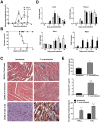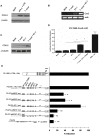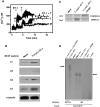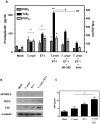Trypanosoma cruzi infection and endothelin-1 cooperatively activate pathogenic inflammatory pathways in cardiomyocytes
- PMID: 23409199
- PMCID: PMC3566987
- DOI: 10.1371/journal.pntd.0002034
Trypanosoma cruzi infection and endothelin-1 cooperatively activate pathogenic inflammatory pathways in cardiomyocytes
Abstract
Trypanosoma cruzi, the causative agent of Chagas' disease, induces multiple responses in the heart, a critical organ of infection and pathology in the host. Among diverse factors, eicosanoids and the vasoactive peptide endothelin-1 (ET-1) have been implicated in the pathogenesis of chronic chagasic cardiomyopathy. In the present study, we found that T. cruzi infection in mice induces myocardial gene expression of cyclooxygenase-2 (Cox2) and thromboxane synthase (Tbxas1) as well as endothelin-1 (Edn1) and atrial natriuretic peptide (Nppa). T. cruzi infection and ET-1 cooperatively activated the Ca(2+)/calcineurin (Cn)/nuclear factor of activated T cells (NFAT) signaling pathway in atrial myocytes, leading to COX-2 protein expression and increased eicosanoid (prostaglandins E(2) and F(2α), thromboxane A(2)) release. Moreover, T. cruzi infection of ET-1-stimulated cardiomyocytes resulted in significantly enhanced production of atrial natriuretic peptide (ANP), a prognostic marker for impairment in cardiac function of chagasic patients. Our findings support an important role for the Ca(2+)/Cn/NFAT cascade in T. cruzi-mediated myocardial production of inflammatory mediators and may help define novel therapeutic targets.
Conflict of interest statement
The authors have declared that no competing interests exist.
Figures




Similar articles
-
Cardioprotective actions of curcumin on the pathogenic NFAT/COX-2/prostaglandin E2 pathway induced during Trypanosoma cruzi infection.Phytomedicine. 2016 Nov 15;23(12):1392-1400. doi: 10.1016/j.phymed.2016.06.017. Epub 2016 Jun 29. Phytomedicine. 2016. PMID: 27765359
-
Cardiopathogenic mediators generated by GATA4 signaling upon co-activation with endothelin-1 and Trypanosoma cruzi infection.Microb Pathog. 2014 Aug;73:47-52. doi: 10.1016/j.micpath.2014.06.001. Epub 2014 Jun 11. Microb Pathog. 2014. PMID: 24927936
-
Trypanosoma cruzi infection induces the expression of CD40 in murine cardiomyocytes favoring CD40 ligation-dependent production of cardiopathogenic IL-6.Parasitol Res. 2016 Feb;115(2):779-85. doi: 10.1007/s00436-015-4805-4. Epub 2015 Nov 3. Parasitol Res. 2016. PMID: 26526953
-
The role of endothelin in the pathogenesis of Chagas' disease.Int J Parasitol. 2001 May 1;31(5-6):499-511. doi: 10.1016/s0020-7519(01)00168-0. Int J Parasitol. 2001. PMID: 11334935 Review.
-
Bioactive lipids in Trypanosoma cruzi infection.Adv Parasitol. 2011;76:1-31. doi: 10.1016/B978-0-12-385895-5.00001-3. Adv Parasitol. 2011. PMID: 21884885 Free PMC article. Review.
Cited by
-
Role of FAK signaling in chagasic cardiac hypertrophy.Braz J Infect Dis. 2020 Sep-Oct;24(5):386-397. doi: 10.1016/j.bjid.2020.08.007. Epub 2020 Sep 12. Braz J Infect Dis. 2020. PMID: 32931757 Free PMC article.
-
Role of cyclooxygenase-2 in Trypanosoma cruzi survival in the early stages of parasite host-cell interaction.Mem Inst Oswaldo Cruz. 2015 Apr;110(2):181-91. doi: 10.1590/0074-02760140311. Mem Inst Oswaldo Cruz. 2015. PMID: 25946241 Free PMC article.
-
Inhibition of cyclooxygenase-1 and cyclooxygenase-2 impairs Trypanosoma cruzi entry into cardiac cells and promotes differential modulation of the inflammatory response.Antimicrob Agents Chemother. 2014 Oct;58(10):6157-64. doi: 10.1128/AAC.02752-14. Epub 2014 Aug 4. Antimicrob Agents Chemother. 2014. PMID: 25092706 Free PMC article.
-
Longistatin in tick saliva blocks advanced glycation end-product receptor activation.J Clin Invest. 2014 Oct;124(10):4429-44. doi: 10.1172/jci74917. J Clin Invest. 2014. PMID: 25401185 Free PMC article.
-
Trypanosoma cruzi Modulates PIWI-Interacting RNA Expression in Primary Human Cardiac Myocytes during the Early Phase of Infection.Int J Mol Sci. 2020 Dec 11;21(24):9439. doi: 10.3390/ijms21249439. Int J Mol Sci. 2020. PMID: 33322418 Free PMC article.
References
-
- PAHO 2007: Pan American Health Organization 2007 (2007) Meeting Conclusions and Recommendations from the Joint IPA-AMCHA Annual Meeting (Quito, Ecuador); Technical Guidelines for Prevention and Control of Chagas Disease; PAHO/MSF Regional Consultation on the Organization and Structure of Health Care (IEC) on Congenital Chagas Disease (CLAP, Montevideo, 17–18 May 2007).
-
- Rocha MO, Teixeira MM, Ribeiro AL (2007) An update on the management of Chagas cardiomyopathy. Exper Rev Anti Infect Ther 5: 727–743. - PubMed
-
- Tanowitz HB, Kaul DK, Chen B, Morris SA, Factor SM, et al. (1996) Compromised microcirculation in acute murine Trypanosoma cruzi infection. J Parasitol 82: 124–130. - PubMed
-
- Mukherjee S, Huang H, Weiss LM, Costa S, Scharfstein J, et al. (2003) Role of vasoactive mediators in the pathogenesis of Chagas' disease. Front Biosci 8: e410–419. - PubMed
-
- Petkova SB, Tanowitz HB, Magazine HI, Factor SM, Chan J, et al. (2000) Myocardial expression of endothelin-1 in murine Trypanosoma cruzi infection. Cardiovasc Pathol 9: 257–265. - PubMed
Publication types
MeSH terms
Substances
LinkOut - more resources
Full Text Sources
Other Literature Sources
Research Materials
Miscellaneous

